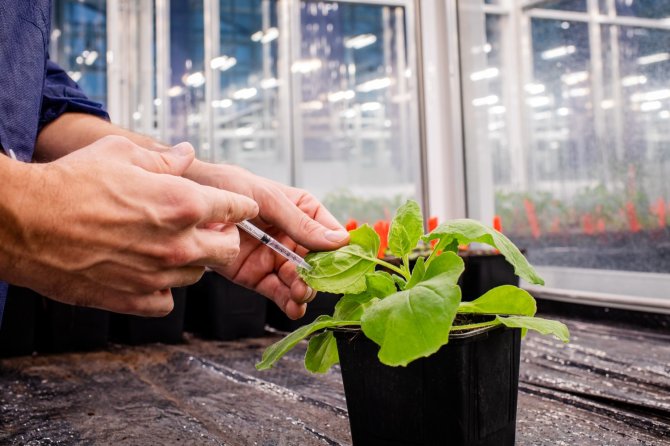Plant sugar structures modified to develop effective worming vaccines
Discovery will provide springboard for vaccines for other parasites in livestock.
December 1, 2023

Mimicking sugar structures in plants plays a crucial role in the development of effective vaccines against the stomach worm Ostertagia ostertagi, a proof-of-concept study by Ruud Wilbers of Wageningen University & Research (WUR) and researchers from Ghent University and Leiden University Medical Center has found. The study shows that a vaccine produced in a plant actually protects cows against the parasite. The insights have been published in an article in Scientific Reports and will provide a springboard for the faster and more sustainable development of vaccines against parasites.
Stomach worm infection is a common condition in cows. Infection can lead to lower milk and meat production and even to illness if the worms burden is high. For that reason, infected cows are treated with deworming agents. But this is creating new problems, according to Wilbers.
“Overuse of these drugs, such as administering too often and at the wrong dose, is causing the parasite to develop resistance to the drugs,” Wilbers explains. “In the Western world in particular, where a lot of livestock farming is intensive, resistance is a growing problem.”
What’s more, Wilbers continues, deworming does not offer a sustainable solution. “It just ensures that the parasite is removed from the animal. But the following year, the infection can return if the cow ingests an egg by eating grass. Since infected cows spread eggs with every bowel movement, pastures remain contaminated, keeping the parasite viable for a long time.”
Another problem with dewormers is that we don’t know exactly what they do, he adds. “They may also end up in meat and milk and spread to the environment and soil.”
Current vaccine production undesirable
A much more effective and sustainable approach is to vaccinate cows against the parasite. There are currently three available vaccines against parasitic worms, Wilbers notes. “The only problem is that, for the production of these vaccines, you have no alternative but to infect animals. Antigens are isolated from living parasites. This method is undesirable, primarily because you then have to infect healthy animals. It is also unsustainable if you want to develop vaccines on a large scale. This is because you would need an awful lot of infected cows to get enough vaccine.”
An alternative production method uses a recombinant expression system. This involves inserting the genetic code from the DNA for an antigen of the parasite into another organism, such as a yeast or bacterium. Wilbers notes: “This process produces the antigen needed to develop the vaccines. The only problem with this method is that it does not work for stomach worms. Researchers from Ghent University spent a decade trying to identify the right antigen. But they found out that this no longer works if you make it in a yeast. This is because other organisms cannot reconstruct the natural sugar structures (glycans) of the parasite.”
Collaboration with Ghent University
At a conference in Greece, Wilbers came into contact with the Ghent researchers and learned of the problem they were facing. “I was there for a presentation on making worm proteins in our plant expression system. We teamed up and started researching how to mimic the parasite’s protein in plants.”
Initially, together with LUMC, the researchers looked at the sugar composition of the parasite and how similar it is to that of plants.
“In stomach worms, the glycans are not very complex compared to other worm parasites. We worked out what sugar residues are on them and what enzymes are needed to make them,” Wilbers explains.
The major advantage of a plant over other expression systems is that a plant has very few enzymes to manipulate sugars, says Wilbers. “This makes it easy to remove existing sugar structures and to start from a ‘naked’ structure. From here you build a new structure, so to speak, by placing sugar cubes on top of it with the chosen enzymes. It’s a bit like Lego for experts. Plants also tolerate this modification. We then allow the enzymes for the new structure to be expressed in the plant together with the antigen.”
Proof-of-concept study shows vaccine effectiveness
With a proof-of-concept study, the researchers have shown that the sugar composition is indeed crucial to the vaccine’s effectiveness.
“This discovery will provide a springboard for vaccines for other parasites in livestock, such as liver fluke, as well as human parasites,” says Wilbers. “We will now conduct several projects to explore the potential further. It is expected that mimicking sugar structures in plants will accelerate the development of vaccines against worm parasites.”
In the future, Wilbers hopes to be able to separate the sugars from the protein altogether.
“With some parasites, you can see that the immune response that offers protection is focused on sugars. If you can separate sugar elements from the protein, that could make vaccine production even easier. This would mean that you only have to look at the parasite’s sugar composition. If we manage to vaccinate with sugar structures, we can develop vaccines even faster. After all, in that case, you don’t have to identify individual antigens anymore.”
About the Author(s)
You May Also Like



